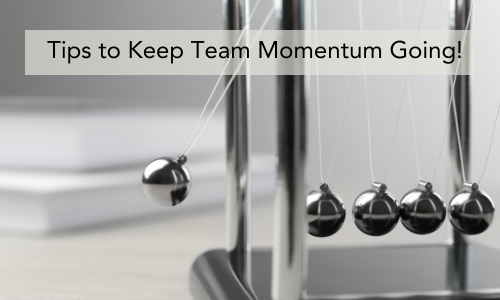In the first two articles of this series, we explored how to regain personal control in times of rapid change and how to guide your team through the pace of transformation with practical, efficient strategies. Once the initial lift is underway, however, many leaders ask: How do we keep this momentum going?
This is where many change efforts lose steam.
Leaders often launch change initiatives with great energy, only to find that the enthusiasm fades, priorities blur, and people drift back into old habits. That’s why sustaining momentum is just as important—and often harder—than creating it.
At the heart of momentum is motivation.
To sustain it, teams need to feel seen, valued, and connected to a shared purpose. A sense of progress, recognition, and clarity is what carries a team forward even when the pace feels relentless.
Strategies to Sustain Change and Drive Long-Term Engagement
- Create a Culture of Acknowledgment and Recognition
One of the most powerful ways to sustain momentum is through consistent recognition. Research shows that employees who feel recognized are more engaged, productive, and loyal. Recognition doesn’t have to be grand—small, frequent acknowledgments of effort and impact go a long way. - Celebrate progress on key initiatives.
- Acknowledge resilience, not just results.
- Share stories of wins and lessons learned.
This reinforces that the work matters—and they matter.
Continue Prioritizing High-Impact Projects
As discussed in our previous article, focusing on a few high-impact priorities helps teams stay focused and energized. Sustaining that focus requires discipline:
- Regularly revisit and re-align around strategic priorities.
- Say no to non-essential work that dilutes impact.
- Be transparent when priorities shift—and why.
This clarity prevents overwhelm and promotes meaningful progress.
Build Rituals That Reinforce Progress
Consistency builds trust. Establish routines like weekly check-ins, monthly “milestone moments,” or quarterly reflections to highlight what’s working and where course correction is needed. These touchpoints keep people engaged, informed, and invested.
Encourage Shared Ownership
When people feel ownership over results, they’re more committed. Invite input, feedback, and collaboration at every level—not just during planning but throughout execution. Ask questions like:
- “What’s getting in the way?”
- “What do we need to do differently?”
- “How can we better support each other?”
Reconnect to Purpose Often
When change gets hard—and it will—purpose is what pulls people through. Remind teams why the work matters, how it connects to the bigger picture, and what’s at stake. Purpose is the fuel that powers sustained effort.
Sustaining momentum through change requires more than process—it requires heart. When leaders create a culture of recognition, maintain clarity on priorities, and reinforce a shared sense of purpose, they build teams that don’t just adapt to change—they thrive through it.
